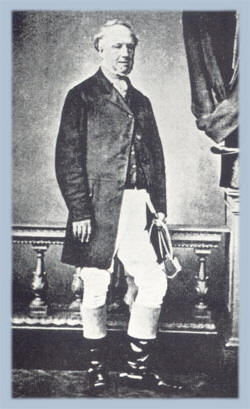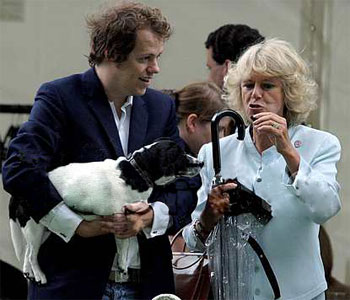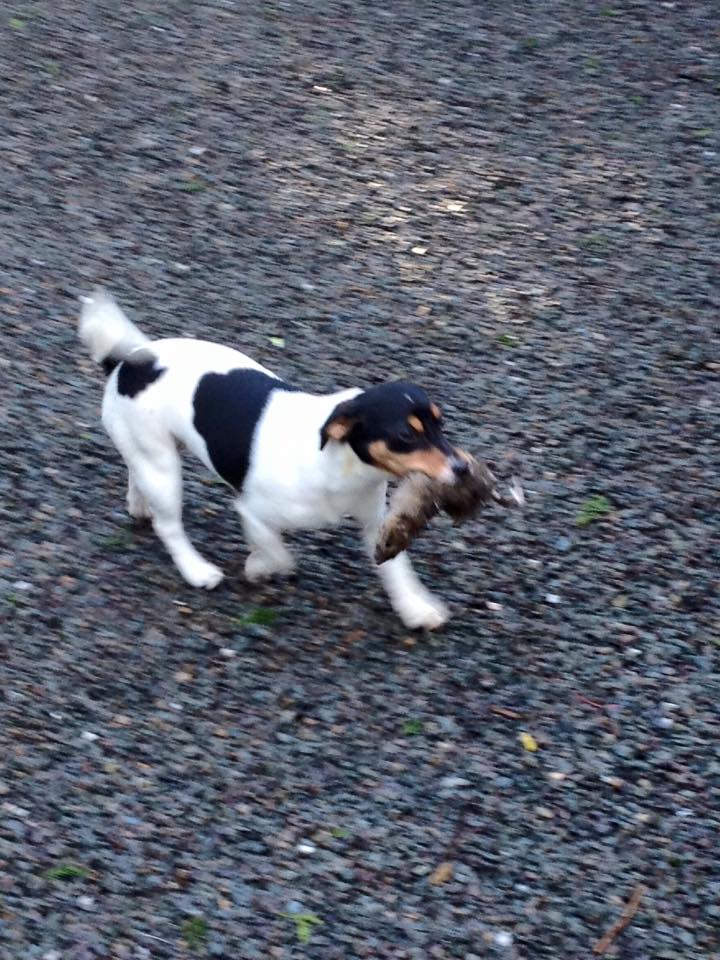

 | ||||||
Our dogs descend from the John Peel line & were first introduced to our family by Joe Bowman who was at the time courting my grandfathers Aunt before my grandfather Edward Mckenzie was even born. In all our family have had the same strain of terriers since 1806 with my Gt Gt grandfather John Sarginson who was a blacksmith being the first person we are aware of in the family to have had a ' JRT hunt terrier', but no one ever kept records back then so we have to work from when my grandfather started to keep records of the dogs in 1950.
We have been made aware though that we have the oldest pure bred line of small JRT's in the world.
Our Jack Russell's today are family dogs who are worked from time to time but not day in day out as we have other things to do! they do have the hunting instinct, so give thought to this when thinking of aproaching me for a puppy as working Jack Russell's are harder to control in a family home if their minds aren't occupied, they are not aggressive or troublesome they just torment your life out wanting to play ball or anything else that they see fit to be entertained with, if you want a dog who will sit on your lap all day without moving a muscle except to eat or go out for the toilet then my Jack Russell's aren't for you go find some other breed, my Jack Russell's are quite happy in our home but they get taken out for very varied & different exercise & environment's so they never become bored, Jack Russell's demand time & attention! & will reward you with the same.

 | ||||||

John Peel was born in 1776 he was well noted for his beautiful hounds but only Cumbrian's & Hunts knew of his terrier's which were just called 'Hunt/Foxing Terrier's' almost every fox working dog was classed as a fox terrier until the early 1900's when the Jack Russell name was given to anything that was white with coloured patches so the name Jack Russell Terrier was applied to our 'hunt terriers'.
Contrary to belief the 'short straight legged Jack Russell' originated & was bred in Cumbria & is in fact not short legged but a dog who is in proportion being 50-50 leg to body, they are not a big dog or anywhere near as leggy as a Parson Russell.
The John Peel strain of terrier also helped establish other lines in the 1860's one being the Kendall Kennels & the other being the famous Carlisle Kennels of well known fox and white lakeland fell terriers owned by Mr W. Carrick, the best of these terriers Carlisle Tack, Carlisle Tyro, Carlisle Trick contrary to popular belief were foundation dogs of the Rev'd John Russells strain of Parson Russell Terriers not the oppisite way round.
Carlisle Tack was whelped around 1884 by Carlisle Trick x Lil Foiler, Tacks grand dam being John Peels 'Buffet' was entirely smooth coated lineage as indeed was most of Tacks line, the wire coat exhibited by Tack and his dam Lil Foiler is thought to have come from the nearest and closest match in the Cumbrian area and that is the Elterwater Terrier also known today as the Fell Terrier, the Fell Terrier is a working unregistered version of a Lakeland Terrier but they differ greatly in appearence today. Carlisle Tack was mated to another bitch by the name of Vice to produce Carlisle Tyro who is another well known foxing terrier.
Prior to 1860 majority of fox terrier type dogs were smooth coated and non pedigree, the fox terrier was bred in the North Of England along with the Border Terrier, Lakeland Terrier etc, in fact most terriers of the UK were from the North rather than the South.

 | ||||||
 | ||||||



 | ||||||
 | ||||||
 | ||||||

 | ||||||

 | ||||||
Rev'd Parson John Russell born in 1795 was responsible for the long legged 'Parson Russell' these dogs served the southern hunts well but his dog's were far too big for use in our Cumbrian fell pack's that is why our Huntsmen produced a smaller Jack Russell which is now known as the shortlegged Jack Russell it has been well documented that the Northern Hunts prefered a smaller dog than the Southern Hunts.
The term “Jack Russell Terrier” was coined after the Reverend John Russell was dead, and was used to differentiate small working terriers from larger nonworking Fox Terriers that, by 1900, dominated the Kennel Club show ring and bench.
The Rev'd John Russell in fact bought and begged dogs from all over the UK it is well talked about in many books, his lines were based around a bitch called Trump that he accquired off an unknown milkman in Oxfordshire and also from the well known Scorrier Fox Terriers in Southern England whom he used to accept unwanted terriers from, Russell brought in working terriers from the Carlisle Kennels in Cumbria to improve his own dogs.
In the lakes our hunts also had the Patterdale/working Lakeland/Fell Terriers also known by their old name 'Elterwater' which are more than capable of disposing of a stubborn fox, these dogs are also generally smaller than the Parson Russell. The Elterwater/Fell terrier has been around and documented since at least 1750.

 | ||||||

 | ||||||

 | ||||||

 | ||||||
Our working Jack Russells originally of the Cumbrian Lakes are the type that were mainly to be seen in the Cumbrian Hunts Kennel's they are not found very often in the rest of the UK as these dog's are kept within the huntsman's pack's and very few are sold to the general public as they are a working dog, some people think they have the traditional shortlegged Jack Russell but in fact they only have the Jack Russell X Dachshund or X Sealyham type's often named as 'queen anne' style & they varie greatly from dog to dog with most of them having short 'bow' legs or overlong bodie's, large heads and strange colouration these dog's are undesirable to working terrier people here & are not proper Jack Russells.
The Jack Russell x Sealyham is known as a Lucas Terrier in the UK and is not dis similar to some JRT strains especially those with very long coats and large heads/ears, short legs.

 | ||||||
At Cumbreck we strive to keep the traditional type and to breed quality not quantity, aimed specifically at the breeds health and function, our dogs history will never be lost to show ring trends, we want a dog that is pleasing to the eye,versatile so that they make good companions or if need arise's they would be keen to work for their owner, smart, cheeky, healthy and have plenty of colour, we don't just want another 'nearly white terrier'! A Jack Russell should be 51% white and upto 49% colour ideally and this is my aim.

 | ||||||

 | ||||||


 | ||||||
 | ||||||

Quote:- In the first place, never breed from an animal whose pedigree is not authenticated beyond a shadow of a doubt; and remember that while like may beget like, the inevitable tendency is to throw back to former generations. The man who elects to breed Fox-terriers must have the bumps of patience and hope very strongly developed, as if the tyro imagines that he has only to mate his bitch to one of the known prize-winning dogs of the day in order to produce a champion, he had better try some other breed. Let him fix in his mind the ideal dog, and set to work by patient effort and in the face of many disappointments to produce it. It is not sufficient that, having acquired a bitch good in all points save in head, that he breeds her to the best-headed dog he can find. He must satisfy himself that the head is not a chance one, but is an inherited one, handed down from many generations, good in this particular, and consequently potent to reproduce its like. So in all other points that he wishes to reproduce. In the writer's experience, little bitches with quality are the most successful. Those having masculine characteristics should be avoided, and the best results will be obtained from the first three litters, after which a bitch rarely breeds anything so good.
 | ||||||
Some quotes from old terriermen.

 | ||||||
Quote:- The Grove Hunt kennels produced "Old Jock," the dog which is recognized as the father of the Fox Terrier, while the Belvoir Hunt gave us "Belvoir Joe," sire of the famous stud dog "Belgrave Joe," and the Oakley Hunt "Old Trap,"from bull terrier lines but another very influential early sire.
These are the founders of the modern Smooth Fox Terrier from which the Wire is an offshoot, probably the result of mating early Smooths with the common black-and-tan terriers of the period. The Rev. Jack Russell bred a strain of working Wires, but it was not until a W. Carrick of Carlisle bred "Tack" that we had an outstanding Fox Terrier
Quote:- The greatest care must be exercised in the matter of coat before any such cross is effected. The smooth that is crossed with the wire must have a really hard, and not too full coat, and, as there are very, very few smooths now being shown with anything like a proper coat for a terrier to possess, the very greatest caution is necessary.
Some few years back, almost incalculable harm was done to the variety by a considerable amount of crossing into a strain of smooths with terribly soft flannelly coats. Good-looking terriers were produced, and therein lay the danger, but their coats were as bad as bad could be; and, though people were at first too prone to look over this very serious fault, they now seem to have recovered their senses, and thus, although much harm was done, any serious damage has been averted. If a person has a full-coated wire-hair bitch he is too apt to put her to a smooth simply because it is a smooth, whom he thinks will neutralise the length of his bitch's jacket, but this is absolute heresy, and must not be done unless the smooth has the very hardest of hair on him. If it is done, the result is too horrible for words: you get an elongated, smooth, full coat as soft as cotton wool, and sometimes as silkily wavy as a lady's hair. This is not a coat for any terrier to possess, and it is not a wire-hair terrier's coat, which ought to be a hard, crinkly, peculiar-looking broken coat on top, with a dense undercoat underneath, and must never be mistakable for an elongated smooth terrier's coat, which can never at any time be a protection from wind, water, or dirt, and is, in reality, the reverse.

 | ||||||
